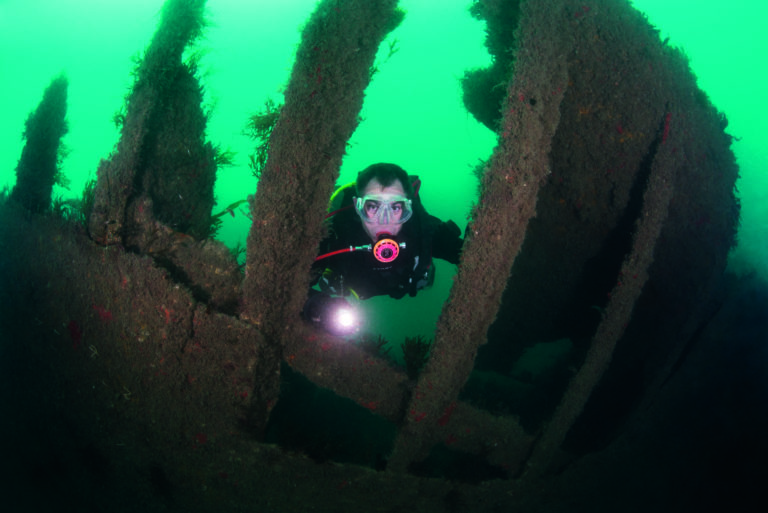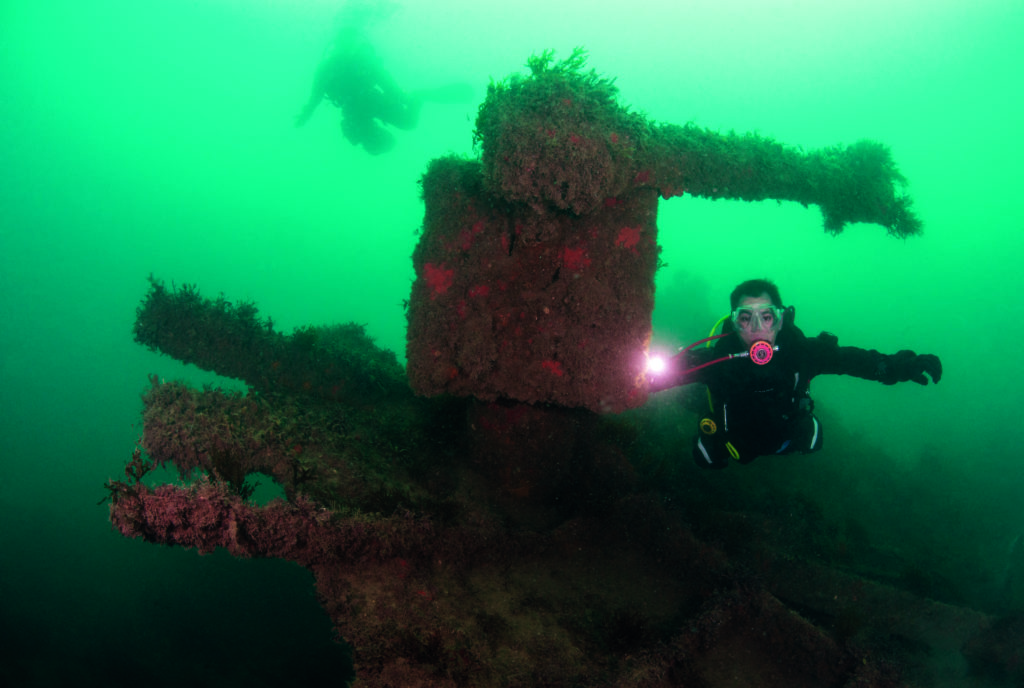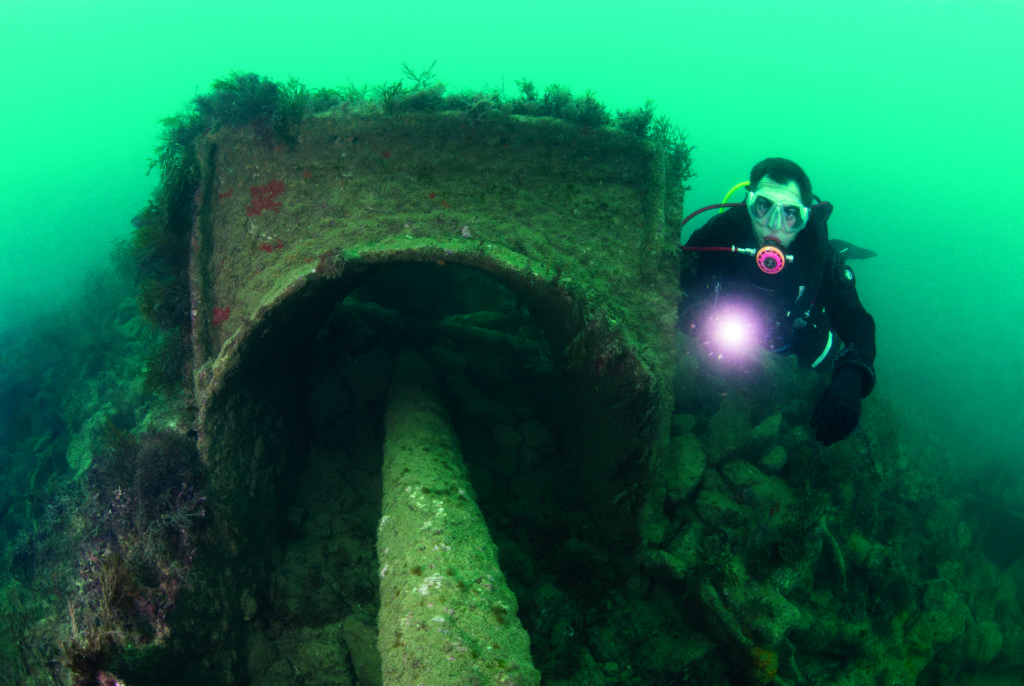STUART PHILPOTT stays close to home when he explores this shallow ‘one-of-three’ wreck just off Portland in Dorset
Over the years, Blacknor Point on Portland in Dorset has attracted its fair share of shipwrecks. The steamship Gertrude hit the rocks and sank in 1894, with Barmston suffering a similar fate in 1918.
HMT James Fennel completed the hat-trick of destruction in 1920. This must have been a distressing time for the crews and the shipping companies, but somebody’s loss usually means someone else’s gain, and on this occasion the beneficiary is definitely the diving community.
It’s possible to explore all three wrecks in one multi-level dive but beware, they are well broken-up and differentiating between one and another is not so easy.
Lying at a maximum depth of around 18m, HMT James Fennel is probably the most intact of the three. Popular with trainee and experienced divers alike, the site is located close to the rocky coastline, well protected from north-easterlies.
It can be dived solely as a wreck-exploration dive or as part of a drift, depending on tidal conditions. A fair proportion of the seabed is covered with massive boulders and kelp, so the hardest task is finding the wreck in the first place!
Although I have been diving around Portland for some 25 years, the Fennel has, on many occasions, slipped under my radar. If I am going shore-diving, the Royal Adelaide or Chesil Cove is my preferred choice. If I book a space on a charter-boat, then I usually visit one of the deeper Lyme Bay favourites.
Only if the weather turns rough or there is time to fit in a second boat-dive do I get a chance to explore the Fennel, which is a shame because this reef, marine-life and wreck combo never fails to deliver.
Arrival at the site
Portland and Weymouth has a tenacious dive-centre community. I still see the same characters I met more than 25 years ago, although not looking so fresh-faced these days. But who am I to talk?
Just about every dive-centre and charter-boat operating out of Weymouth and Portland offers the HMT James Fennel as part of its diving manifest. A number of boats are for hire in Weymouth, as well as a small selection of dive-clubs with their own boat facilities, or contact the Old Harbour Dive Centre.
Skin Deep Diving is based at Portland Marina. Follow the main beach road (A354) onto the causeway. Carry on past the Fine Foundation Chesil Beach Centre car park, turn left at the mini-roundabout and then follow the signs to the marina. Or carry on to the next roundabout and take the left turn.
O’Three Drysuits and Underwater Explorers can be seen from the road side (the latter is a convenient stop for gas top-ups and any dive-kit issues) and then follow the road signs to the marina complex.
Portland Marina was built for the 2012 Olympics. It offers the full range of boat services, including overhauls, hard-standings and moorings. Skin Deep and the Boat That Rocks bar/restaurant are located on site. Skin Deep, run by Ian and Oona, offers regular shuttles to the harbour dive-sites, including the Dredger and Balaclava Bay. Cost is £28 for a dive on the James Fennel, and car-parking is free.
Carry on into Castletown, where the Aqua Hotel and Dive Beyond reside. The café, managed by local diver Angel, cooks up a mean full English as well as offering a range of healthier options. The hotel has 25 very reasonably priced rooms available, as well as a bar and on-site lecture facilities.
Dive Beyond sits snugly next to the hotel. This dive-centre is managed by PADI CD Dale Spree, a great character and highly respected in the diving industry. Dive Beyond charges around £25pp for a RIB dive on the Fennel. The Castletown car-park fee is about £3 for four hours. Early risers might be able to find an empty space along the roadside.
Dive briefing
The James Fennel is located on the west side of Portland and can be accessed only by boat. Journey times are usually 30-45 minutes depending on the dive-centre you choose.
From the drop-off point, finding the wreck should be a no-brainer. Divers descend to around 15-16m and fin north or south along the seabed (depending where the boats drops them off) until they find signs of metal.
Then it’s just a case of following the wreckage trail. The Gertrude is shallowest at 6m-14m and the Barmston slightly deeper at 22m. Normally I would choose a 12-litre cylinder filled with either air or nitrox, but heavy breathers should consider using a 15-litre. SMBs are required. There can be currents, so it’s wise to dive at slack water.
The bottom topography consists mainly of huge boulders and patches of gravel. The wreck-site itself covers quite a small area, with many parts camouflaged by flora growth, and the stern stands around 5m proud of the seabed. There are one or two tight overhead sections, but otherwise the wreck is well broken up, with a good variety of marine life.
Regular fish sightings include conger eels, blennies, wrasse and pollack, with seasonal visits from cuttlefish, rays and john dory. Edible and velvet swimming crabs are always on show, as well as lobsters and these days even crawfish. Underwater visibility can top 10m, but I would say that 5m is a reasonable average.
James Fennel’s sinking
The 35m, 215-ton HMT James Fennel was built for the Admiralty by Fullerton & Co in Paisley in 1918. Categorised as a Strath-class auxiliary patrol vessel prefixed HMT (Her Majesty’s Trawler), it was powered by a 430hp triple-expansion engine, manned by a crew of 18 and armed with a 12-pounder deck-gun.
On 16 January, 1920, bound for Portsmouth from Gibraltar, it hit rocks north of Blacknor Point while navigating through thick fog. On hearing the commotion, local fishermen managed to scramble down the slippery rocks and secure a rope from the stricken ship to the shore before guiding the crew to safety. No loss of life was reported.
A few days later, attempts were made to tow the Fennel off the rocks, but it was badly holed and sank immediately.
I couldn’t find any record of salvage attempts or of what became of the deck-gun. Unless my eyesight is worse than I thought, there is no sign of a gun in any of the Internet pictures showing the ship perched on the rocks, so perhaps it wasn’t fitted at the time of sinking.
Just 20m south of the Fennel in the shallows between 6m-14m lies the Gertrude. This 43m, 1,377-ton cargo ship was built by William Gray & Sons at West Hartlepool in 1879, fitted with a two-cylinder 80hp engine and a single propeller.
On 26 August, 1894, the ship ran aground in fog while carrying a cargo of iron pyrites. All 18 crew and two passengers survived. This wreck is also well broken-up and it’s difficult to tell what is reef or wreck. The most prominent feature is the boiler.
At around 22m are the remains of the 76m, 1,451-ton collier Barmston, built in Norway in 1888. She sank on 3 March, 1918 while sailing from Swansea to Rouen. All 20 crew survived.
The dive
Result. I had picked a bright, sunny autumn day with a slight north-easterly breeze and very little swell. Dale Spree had fuelled up Dive Beyond’s big yellow RIB (complete with new engine) and was preparing for a rapid departure.
The plan was to blast around to the James Fennel, spend no more than an hour on site, continue to the Royal Adelaide for some triggerfish action, and then head back around the Bill to Portland Harbour for a third dive.
Just to round off my good luck, I ran into some old diving friends. Kevin Craddock, owner of the Flippas n Fins Dive Centre, who was guiding a couple of punters, and local diver Alex Charleton. Alex had for some years been collating data on undulate ray populations at Portland’s shore-diving sites and sharing his findings on Facebook. I was astounded by some of the unusual nocturnal species he had photographed, including squid, octopuses and anglerfish.
Alex was far more familiar with the Fennel than me, so I “volunteered” him as wreck-finder. Kevin had brought his son Ian into the family business several years ago and he had worked his way up the PADI ladder to the dizzy heights of Course Director, quite an achievement. I nominated Ian as my photographic model, bringing him down to reality with a huge bump!
Dale arrived at Blacknor Point on schedule. The plan was to drop onto the seabed at around 16m and then head towards the rocks. Of course, the wreck would be right in front of us and we would spend the rest of the dive working out the best compositions for pictures in a calm, relaxed manner
In the event, the Fennel was nowhere to be seen. For the next 20 minutes I was head-down finning like a lunatic trying to keep up with Alex while we searched back and forth for the wreck. I’m sure he could hear me cursing through my regulator.
Just as I thought all was lost, Alex pointed out a couple of stanchions covered in thick weed. I checked my depth and realised that at 12m this was probably part of the Gertrude.
I followed Alex slightly deeper and came across more wreckage – huge metal plates scattered over the seabed. I managed to squeeze Ian into an overhead section for an atmospheric composition, but we had disturbed too much silt.
Alex went scouting ahead, finding bits of the wreck for me to photograph. We stopped at what looked to be a prop shaft. I managed to fire off a few shots, both landscape and portrait, with surprisingly little backscatter.
Slightly deeper, we found the remains of the stern. This was probably the most photogenic area, with some nice upright sections, but by now we were running short of time. Alex had already mentioned that there was not much to see around the boiler and prop, so we didn’t bother going any further.
There was just enough time for our hostess, Dale, to serve up some hot Ribena rounded off with a Cadbury’s Freddo bar, and then we were kitting up for our next dive.
Conclusion
It’s not often that I get a chance to explore three historical wrecks in one go and, on this occasion, I didn’t! My plan had been to focus on HMT James Fennel, which we did find eventually, and seeing some of the Gertrude was a bonus.
In my rush to get pictures I didn’t get a chance to check out the site thoroughly, but from what I could see there was a substantial amount of low-lying wreckage. Combined with the massive boulders and marine-life sightings, and despite me probably seeing more of the surrounding reef than the wreck, it added up to an enjoyable dive.
It’s easy to see why this fairly shallow site is popular with clubs and dive-centres. With few overhead sections to get stuck inside, the Fennel makes a good first wreck dive – as long as you can find it!
Photographs by Stuart Philpott
Also on Divernet: Blue Shark Encounters In Cornwall, Diving Kimmeridge Bay, The ‘Wick’ At St Abbs, The Swanage Pier Dive, The Countess Of Erne, Diving At Drawna Rocks, Diving Puffin Island




